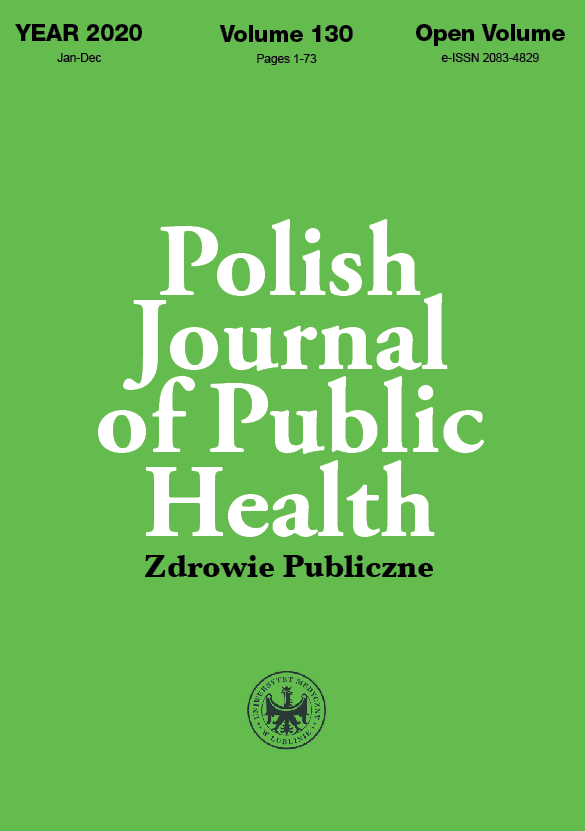The pH of soaps, skin care products and cosmetics used in the period of COVID-19 pandemic
DOI:
https://doi.org/10.2478/pjph-2020-0013Keywords:
soaps, skin care products, pH, COVID19 pandemicAbstract
Introduction. Human skin is the outer cover of the body. It performs important functions for the entire organism, such as protection of internal organs. The skin also protects the body against the effects of the external environment, ensures the balance between the environment and the inside of organism. Due to the pandemic, all members of the public are encouraged to frequently wash or disinfect hands, which may lead to skin irritation.
Aim. The aim of the study was to check the pH of soaps, skin care products and selected cosmetics used in the period of COVID-19 pandemic.
Materials and methods. For pH determination the CP-105 pH meter manufactured by ELMETRON® (Poland) was used. A total of 111 products available on the Polish market were collected for testing. The results were compared with the pH of tap water samples.
Results. The soaps had mean pH of 5.04±1.04, shampoos 6.04±1.57, creams 6.87±0.1, products for depilation 9.8±3.06. All the values were within legal ranges.
Conclusion. The majority of skin and hair cosmetics have pH close to the pH of tap water. Chemical hair removal products have the most alkaline pH and therefore, require extreme caution as they can cause irritation.
References
1. Molski M. Chemia piękna. Warszawa: Wyd. PWN; 2009. p. 2-26.
2. Shingyoji A, Tokumaru O, Ogata K, Yokoi I. Impact of makeup on quality of life of Japanese married couples: does makeup improve quality of life of wife as well as that of husband? Gazzetta Medica Italiana – Archivo per le Scienze Mediche. 2020;179(3):117-23.
3. Jabłońska S, Chorzelski T. Choroby skóry dla studentów medycyny i lekarzy. Warszawa: Wyd. Lekarskie PZWL; 1994. p. 15-23.
4. Yosipovitch G, Maibach H. Departament of Dermatology, UCSF Medical Center, San Francisco, CA, USA. Skin Surface pH: A Protective Acid Matnle. Cosmetics & Toiletries Mag. 1996;111(12):12-6.
5. Ali SM, Yosipovitch G. Skin pH: From basic science to basic skin care. Acta Derm Venereol. 2013;93:261-7.
6. World Health Organization. Wytyczne WHO dotyczące higieny rąk w opiece zdrowotnej – podsumowanie. World Health Organization; 2009.
7. European Centre for Disease Prevention and Control. Wytyczne dotyczące noszenia i zdejmowania środków ochrony indywidualnej w placówkach opieki zdrowotnej w trakcie opieki nad pacjentami chorymi lub podejrzewanymi o zachorowanie na COVID-19. Sprawozdanie techniczne ECDC; 2020.
8. Duszyński J, Afelt A, Ochab-Marcinek A, et al. Zrozumieć COVID-19. Opracowanie zespołu ds. COVID-19. Przy prezesie Polskiej Akademii Nauk. Warszawa: Polska Akademia Nauk; 2020.
9. Kocjan R. Chemia analityczna. Podręcznik dla studentów. Tom I. Warszawa: Wyd. Lekarskie PZWL; 2002. p. 59-65.
10. Szmal Z, Lipiec T. Chemia analityczna z elementami analizy instrumentalnej. Podręcznik dla studentów farmacji. Warszawa: Wyd. PZWL; 198. p. 45-6.
11. Minczewski J, Marczenko Z. Chemia analityczna. Podstawy teoretyczne i analiza jakościowa. Tom 1. Warszawa: Wyd. Naukowe PWN; 2001. p. 53.
12. Nieradko-Iwanicka B, Chrobok K, Skolarczyk J, Pekar J. What is the pH, Fe and CI2 content of cosmetics we use? – a pilot study on safety of skin care products. Pol J Public Health. 2017;127 (2):78-81.
13. Ustawa o kosmetykach z 30 marca 2001 r. o kosmetykach, Dz.U. Nr 42, poz. 473 z późn. zm., art. 2 pkt 1. [http://isap.sejm.gov.pl/DetailsServlet?i d=WDU20010420473 downloaded on Nov26th 2020]
14. Jaremek A, Chodun W, Piechnik J, Nieradko-Iwanicka B. The influence of wearing masks and gloves due to COVID-19 pandemic on skin problems and skin care in students of Medical University in Lublin. J Educ Health Sport. 2020;10(11):82-8.
15. Li C, Shen J, Ju Y, et al. Management and prevention of common skin problems during epidemic prevention and control of COVID-19. Nan Fang Yi Ke Da Xue Xue Bao. 2020;40(2):168-70
Downloads
Published
Issue
Section
License
Copyright (c) 2021 Polish Journal of Public Health

This work is licensed under a Creative Commons Attribution-NonCommercial-NoDerivatives 3.0 Unported License.


